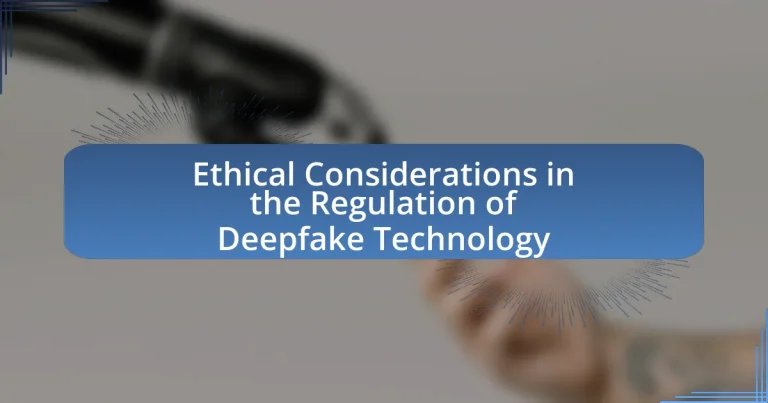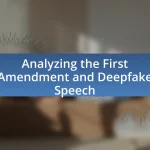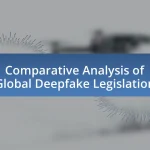The article focuses on the ethical considerations surrounding the regulation of deepfake technology, highlighting issues such as misinformation, privacy violations, and consent. It emphasizes the importance of regulating deepfakes to protect individual rights and maintain trust in media, while also addressing potential harms like identity theft and the erosion of public confidence. The article explores various ethical frameworks, including utilitarianism and deontological ethics, and discusses the roles of key stakeholders, including government agencies and technology developers, in shaping effective regulatory measures. Additionally, it examines current legal frameworks, technological solutions for detection, and best practices for ensuring ethical use of deepfake technology.

What are the Ethical Considerations in the Regulation of Deepfake Technology?
The ethical considerations in the regulation of deepfake technology include the potential for misinformation, privacy violations, and the impact on consent. Misinformation arises as deepfakes can be used to create realistic but false narratives, undermining trust in media and public figures. Privacy violations occur when individuals’ likenesses are manipulated without their consent, leading to potential reputational harm. Additionally, the lack of clear guidelines on consent raises ethical dilemmas regarding the use of someone’s image or voice in deepfake content. These considerations necessitate a balanced regulatory approach that protects individuals while fostering innovation in technology.
Why is it important to regulate deepfake technology?
Regulating deepfake technology is crucial to prevent misinformation and protect individuals’ rights. Deepfakes can be used to create misleading content that damages reputations, influences public opinion, and undermines trust in media. For instance, a study by the University of California, Berkeley, found that deepfake videos can significantly alter viewers’ perceptions of political figures, demonstrating their potential to manipulate democratic processes. Additionally, without regulation, individuals may become victims of identity theft or harassment through the unauthorized use of their likenesses in deepfake content. Therefore, establishing guidelines and legal frameworks is essential to mitigate these risks and ensure ethical use of this technology.
What potential harms can arise from unregulated deepfake technology?
Unregulated deepfake technology can lead to significant harms, including misinformation, identity theft, and erosion of trust in media. Misinformation can spread rapidly through manipulated videos, influencing public opinion and potentially swaying elections, as evidenced by instances during the 2020 U.S. presidential election where deepfakes were used to create misleading narratives. Identity theft occurs when individuals’ likenesses are used without consent, leading to reputational damage and emotional distress. Furthermore, the erosion of trust in media is evident as audiences become increasingly skeptical of video content, which can undermine legitimate journalism and public discourse. These harms highlight the urgent need for regulatory frameworks to address the ethical implications of deepfake technology.
How does deepfake technology impact trust in media?
Deepfake technology significantly undermines trust in media by enabling the creation of highly realistic but fabricated audio and video content. This capability allows malicious actors to manipulate public perception, leading to misinformation and disinformation campaigns that can distort reality. For instance, a study by the University of California, Berkeley, found that 96% of participants could not distinguish between real and deepfake videos, highlighting the potential for deepfakes to mislead audiences. As a result, the proliferation of deepfake content can erode public confidence in legitimate media sources, making it increasingly difficult for individuals to discern truth from deception.
What ethical frameworks can be applied to deepfake regulation?
Utilitarianism and deontological ethics are two primary ethical frameworks that can be applied to deepfake regulation. Utilitarianism focuses on the consequences of actions, advocating for regulations that maximize overall societal well-being by minimizing harm caused by deepfakes, such as misinformation or defamation. Deontological ethics, on the other hand, emphasizes the importance of moral duties and rights, suggesting that regulations should protect individuals’ rights to privacy and consent, regardless of the outcomes. These frameworks provide a structured approach to addressing the ethical dilemmas posed by deepfake technology, ensuring that regulations balance societal benefits with individual rights.
How do utilitarian principles guide the regulation of deepfakes?
Utilitarian principles guide the regulation of deepfakes by emphasizing the greatest good for the greatest number, focusing on minimizing harm and maximizing societal benefits. This approach leads regulators to consider the potential negative impacts of deepfakes, such as misinformation, privacy violations, and emotional distress, while also recognizing their potential for positive uses, like entertainment and education. For instance, regulations may prioritize transparency and accountability in deepfake technology to prevent misuse, thereby protecting public trust and safety, which aligns with utilitarian goals of overall societal welfare.
What role do deontological ethics play in this context?
Deontological ethics play a crucial role in the regulation of deepfake technology by emphasizing the importance of moral duties and principles over the consequences of actions. This ethical framework asserts that certain actions, such as creating misleading or harmful deepfakes, are inherently wrong regardless of their potential outcomes. For instance, the violation of individual rights and the potential for deception are central concerns in this context, as deepfakes can infringe upon personal autonomy and trust. By prioritizing adherence to ethical principles, such as honesty and respect for individuals, deontological ethics guide policymakers in establishing regulations that protect against the misuse of deepfake technology, ensuring that ethical standards are upheld in the digital landscape.
What are the key stakeholders in deepfake regulation?
The key stakeholders in deepfake regulation include government agencies, technology companies, civil society organizations, and academic institutions. Government agencies are responsible for creating and enforcing laws that address the ethical implications and potential harms of deepfake technology. Technology companies, such as social media platforms and software developers, play a crucial role in implementing measures to detect and mitigate the misuse of deepfakes. Civil society organizations advocate for ethical standards and consumer protection, raising awareness about the risks associated with deepfakes. Academic institutions contribute research and expertise to inform policy decisions and technological advancements in the field. These stakeholders collectively influence the development and enforcement of regulations surrounding deepfake technology.
How do technology developers influence ethical considerations?
Technology developers influence ethical considerations by designing and implementing algorithms that determine how deepfake technology is used and perceived. Their choices in coding, data selection, and user interface design can either promote responsible usage or facilitate harmful applications, such as misinformation or privacy violations. For instance, the development of deepfake detection tools by technology companies aims to mitigate the risks associated with malicious deepfake content, demonstrating a proactive approach to ethical responsibility. Additionally, industry standards and guidelines established by developers can shape public discourse and regulatory frameworks, influencing societal norms around the ethical use of technology.
What responsibilities do policymakers have regarding deepfakes?
Policymakers have the responsibility to create regulations that address the ethical implications and potential harms of deepfake technology. This includes establishing legal frameworks to prevent misinformation, protect individuals’ rights, and ensure accountability for malicious uses of deepfakes. For instance, in 2020, California enacted a law making it illegal to use deepfake technology to harm or defraud others, demonstrating a proactive approach to mitigate risks associated with this technology. Additionally, policymakers must engage with technology experts and stakeholders to stay informed about advancements and potential abuses, ensuring that regulations remain relevant and effective in safeguarding public interest.
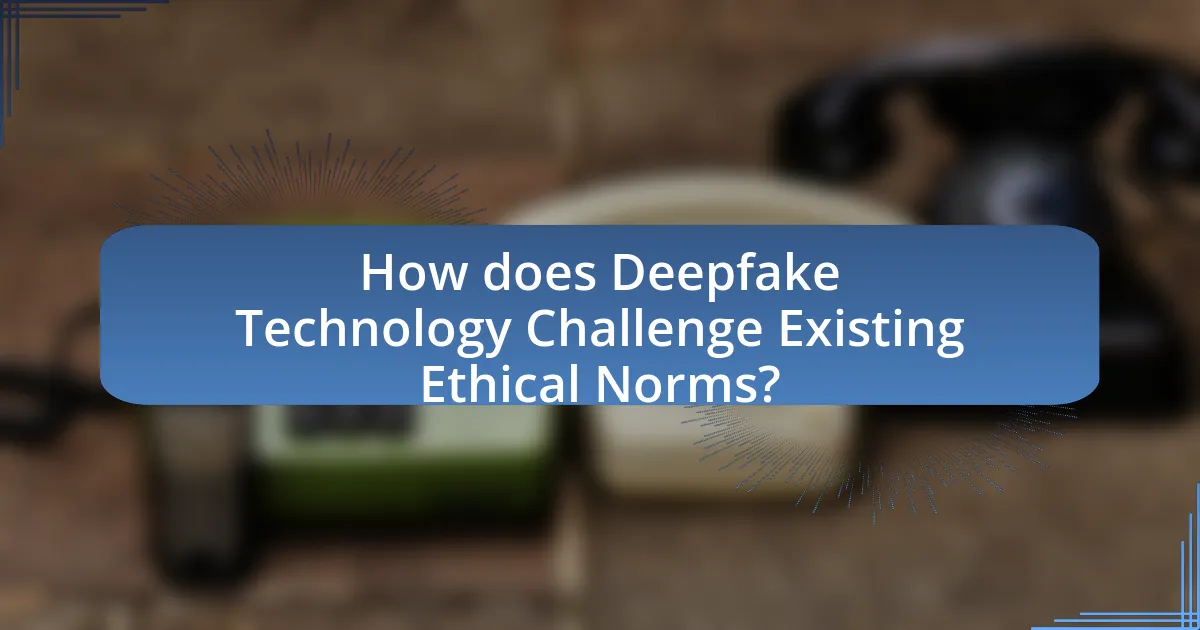
How does Deepfake Technology Challenge Existing Ethical Norms?
Deepfake technology challenges existing ethical norms by enabling the creation of hyper-realistic manipulated media that can mislead audiences and violate individual privacy. This technology raises significant concerns regarding consent, as individuals can be depicted in compromising or false scenarios without their approval, undermining personal autonomy. For instance, deepfakes have been used in non-consensual pornography, which has led to legal and ethical debates about the rights of individuals to control their own likenesses. Furthermore, the potential for deepfakes to spread misinformation poses a threat to public trust in media and institutions, as seen during election cycles where manipulated videos can influence voter perceptions. These challenges necessitate a reevaluation of existing ethical frameworks to address the implications of deepfake technology on society.
What are the implications of deepfakes on privacy rights?
Deepfakes significantly undermine privacy rights by enabling the unauthorized creation and distribution of realistic but fabricated audio and visual content. This technology allows individuals to manipulate images and videos of others without consent, leading to potential reputational harm, harassment, and identity theft. For instance, a study by the University of California, Berkeley, found that deepfake technology can be used to create non-consensual pornography, which violates personal privacy and can have devastating emotional and social consequences for victims. Furthermore, the ease of access to deepfake creation tools exacerbates the risk of privacy violations, as individuals can produce harmful content with minimal technical skills.
How can deepfakes violate individual consent?
Deepfakes can violate individual consent by using a person’s likeness or voice without their permission, often leading to misrepresentation or harm. This unauthorized use can occur in various contexts, such as creating misleading videos that portray individuals in compromising or false situations. For instance, a study by the University of California, Berkeley, highlights that deepfake technology can be exploited to produce non-consensual pornography, which significantly impacts the victim’s reputation and mental health. Such actions not only breach personal autonomy but also raise serious ethical concerns regarding privacy and consent in the digital age.
What are the challenges in enforcing privacy laws against deepfakes?
Enforcing privacy laws against deepfakes presents significant challenges due to the technology’s rapid evolution and the difficulty in identifying the creators and distributors of such content. The anonymity provided by the internet complicates legal accountability, as many deepfake creators operate under pseudonyms or from jurisdictions with lax regulations. Additionally, existing privacy laws often lack specific provisions addressing the unique characteristics of deepfakes, leading to gaps in legal protection. For instance, the General Data Protection Regulation (GDPR) in Europe does not explicitly cover the manipulation of images or videos without consent, making it challenging to prosecute deepfake cases effectively. Furthermore, the technical sophistication of deepfake technology can hinder detection efforts, as many deepfakes are increasingly realistic and difficult to distinguish from genuine content. These factors collectively impede the enforcement of privacy laws, leaving individuals vulnerable to misuse of their likenesses without adequate legal recourse.
How do deepfakes affect freedom of expression?
Deepfakes significantly impact freedom of expression by enabling the creation of misleading or harmful content that can distort public discourse. This technology allows individuals to fabricate realistic audio and video, which can be used to spread misinformation, manipulate opinions, and damage reputations. For instance, a study by the University of California, Berkeley, found that deepfake videos can lead to a 70% decrease in trust in media sources, undermining the public’s ability to discern truth from falsehood. Consequently, while deepfakes can be used for creative expression, their potential for misuse raises ethical concerns regarding the integrity of communication and the protection of individual rights.
What are the risks of censorship in regulating deepfakes?
Censorship in regulating deepfakes poses significant risks, including the suppression of free speech and the potential for abuse of power by authorities. When governments or organizations impose strict regulations, they may inadvertently stifle legitimate expression and creativity, as seen in various historical contexts where censorship has led to the silencing of dissenting voices. Furthermore, the lack of clear guidelines can result in arbitrary enforcement, where individuals may face penalties for content that does not genuinely pose harm. This ambiguity can create a chilling effect, discouraging individuals from engaging in open discourse or artistic expression. Additionally, censorship can lead to the proliferation of misinformation, as individuals may turn to unregulated platforms to share content, undermining the very purpose of regulation.
How can regulation balance free speech and protection from harm?
Regulation can balance free speech and protection from harm by implementing targeted laws that restrict harmful speech while preserving the right to express diverse opinions. For instance, regulations can focus on preventing the dissemination of deepfake technology that misleads or incites violence, thereby protecting individuals from potential harm without broadly infringing on free speech rights. Historical examples, such as the implementation of laws against hate speech in various countries, demonstrate that it is possible to create legal frameworks that address specific harmful content while allowing for robust public discourse.
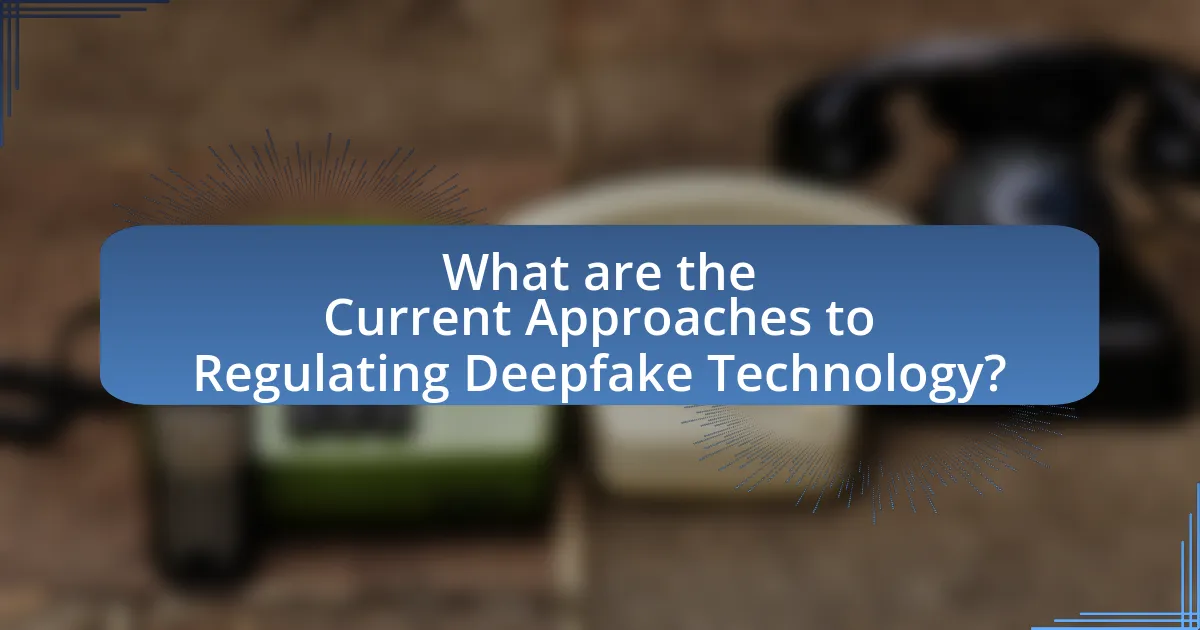
What are the Current Approaches to Regulating Deepfake Technology?
Current approaches to regulating deepfake technology include legislative measures, industry self-regulation, and technological solutions. Governments in various countries, such as the United States and the European Union, are proposing laws that specifically target the malicious use of deepfakes, including penalties for creating or distributing deceptive content without consent. For instance, California enacted a law in 2018 that criminalizes the use of deepfakes for harassment or fraud. Additionally, industry stakeholders are developing guidelines and best practices to promote ethical use, while technology companies are investing in detection tools to identify deepfake content. These combined efforts aim to mitigate the risks associated with deepfakes while balancing innovation and freedom of expression.
What legal frameworks currently exist for deepfake regulation?
Currently, legal frameworks for deepfake regulation include various state laws in the United States, federal proposals, and international guidelines. For instance, California and Texas have enacted laws specifically targeting malicious deepfakes, with California’s law criminalizing the use of deepfakes to harm or defraud individuals, and Texas’s law addressing the use of deepfakes in elections. Additionally, the proposed DEEPFAKES Accountability Act at the federal level aims to require disclosure of deepfake content and impose penalties for malicious use. Internationally, the European Union’s Digital Services Act includes provisions that could impact deepfake technology by holding platforms accountable for harmful content. These frameworks reflect a growing recognition of the potential risks associated with deepfake technology and the need for regulatory measures to address them.
How effective are current laws in addressing deepfake issues?
Current laws are moderately effective in addressing deepfake issues, primarily focusing on existing frameworks like copyright, defamation, and privacy laws. These laws can be applied to some deepfake cases, particularly when they infringe on intellectual property rights or cause reputational harm. However, the rapid evolution of deepfake technology often outpaces legal adaptations, leading to gaps in regulation. For instance, the U.S. has seen state-level legislation, such as California’s law against the malicious use of deepfakes in elections, but comprehensive federal regulations are still lacking. This inconsistency highlights the need for more targeted legal measures to effectively combat the unique challenges posed by deepfakes.
What gaps exist in the current regulatory landscape?
The current regulatory landscape for deepfake technology lacks comprehensive frameworks addressing the ethical implications of its use. Existing regulations often focus on specific aspects, such as privacy or intellectual property, but fail to encompass the broader ethical concerns, including misinformation, consent, and potential harm to individuals and society. For instance, while some jurisdictions have enacted laws against malicious deepfakes, there is no uniform standard that addresses the nuances of consent and the potential for misuse across different contexts. This gap leaves individuals vulnerable to exploitation and misinformation, as highlighted by the increasing prevalence of deepfake incidents in political and social spheres, which can undermine trust in media and institutions.
What role do technological solutions play in regulation?
Technological solutions play a crucial role in regulation by enabling the monitoring, detection, and enforcement of compliance with laws and standards. For instance, advanced algorithms and artificial intelligence can identify deepfake content, allowing regulators to swiftly address misinformation and potential harm associated with such technology. The use of these solutions is supported by studies showing that AI-driven detection methods can achieve over 90% accuracy in identifying manipulated media, thereby reinforcing the effectiveness of regulatory frameworks in combating the misuse of deepfake technology.
How can AI be used to detect and mitigate deepfakes?
AI can be used to detect and mitigate deepfakes through advanced algorithms that analyze video and audio content for inconsistencies and anomalies. These algorithms employ techniques such as deep learning and computer vision to identify subtle artifacts that are often present in manipulated media, such as unnatural facial movements or mismatched audio-visual synchronization. For instance, research conducted by the University of California, Berkeley, demonstrated that AI models could achieve over 90% accuracy in distinguishing between real and deepfake videos by examining pixel-level discrepancies. Additionally, AI can be utilized to watermark original content, enabling verification of authenticity and helping to trace the origin of media, thereby reducing the spread of deepfakes.
What are the limitations of technological solutions in regulation?
Technological solutions in regulation face significant limitations, primarily due to their inability to fully address ethical concerns and the dynamic nature of technology. For instance, while algorithms can detect deepfakes, they often struggle with the rapid evolution of techniques used to create them, leading to a lag in regulatory effectiveness. Additionally, technological solutions may not account for the nuanced ethical implications of deepfake usage, such as consent and misinformation, which require human judgment and contextual understanding. Furthermore, reliance on technology can create a false sense of security, as automated systems can be bypassed or manipulated, undermining regulatory efforts. These limitations highlight the necessity for a balanced approach that combines technological tools with human oversight and ethical frameworks.
What best practices should be considered for ethical deepfake regulation?
Best practices for ethical deepfake regulation include establishing clear legal definitions of deepfakes, implementing transparency requirements for creators, and promoting public awareness about the technology. Clear legal definitions help delineate harmful deepfakes from benign uses, ensuring that regulations target malicious intent. Transparency requirements mandate that creators disclose when content is artificially generated, allowing viewers to make informed decisions. Public awareness campaigns educate individuals about the potential risks and implications of deepfakes, fostering critical consumption of media. These practices are supported by the need for accountability and informed consent, as highlighted in studies on media literacy and misinformation.
How can stakeholders collaborate to create effective regulations?
Stakeholders can collaborate to create effective regulations by establishing multi-stakeholder forums that include technology developers, policymakers, legal experts, and civil society representatives. These forums facilitate open dialogue, allowing stakeholders to share insights and concerns regarding the implications of deepfake technology. For instance, the European Union’s approach to regulating artificial intelligence emphasizes stakeholder engagement through public consultations and expert groups, which helps in drafting regulations that are informed by diverse perspectives and expertise. This collaborative process ensures that regulations are not only technically sound but also ethically aligned with societal values, thereby enhancing their effectiveness and acceptance.
What guidelines can be established to ensure ethical use of deepfake technology?
To ensure the ethical use of deepfake technology, guidelines should include transparency, consent, and accountability. Transparency mandates that creators disclose the use of deepfake technology in their content, allowing viewers to understand the nature of the media they consume. Consent requires that individuals depicted in deepfakes provide explicit permission for their likeness to be used, safeguarding personal rights and privacy. Accountability establishes legal repercussions for malicious use, such as defamation or misinformation, thereby deterring unethical applications. These guidelines are supported by ongoing discussions in academic and legal circles, emphasizing the need for responsible innovation in digital media.
